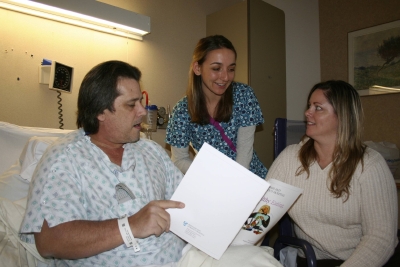Providing Patient and Family Centered Care

Karen Lamping, BSN, RN, of Tower 12B, reviews discharge instructions with patient Michael McNamara and his sister Maureen.
Joan Dorr, BSN, RN, likes having family members present as she cares for her patients.
“They can see how well we care for their loved ones,” said Dorr, a staff nurse on Tower 8AB, the Cardiac Surgery Step Down Unit. “It often eases their anxiety during a difficult time.”
However, family presence in patient rooms sometimes can cause anxiety among staff, and when a patient has several family members in and around their room, it can lead to confusion. That’s why BWH tapped clinical nurses and other care providers during the last year to develop guidelines for accommodating and communicating with family members.
“We have always done well in welcoming and involving family in patient care at the Brigham,” said Mary Lou Moore, MSN, RN, CCRN, director of Cardiovascular Nursing and Clinical Services. “With more single-bed patient rooms with dedicated space for families coming in the Shapiro Center and more planned for the Tower, we have an opportunity to expand and enhance our relationship with our patients and their families.”
This spring, the Carl J. and Ruth Shapiro Cardiovascular Center will open with 136 private rooms featuring dedicated space that makes it more comfortable for family members to spend the night with their loved ones who are patients. As inpatient units in the Tower are renovated in coming years, more single-occupancy rooms with the same dedicated family space will become available.
“Initially, there were some concerns about how the enhanced presence of families could affect how we deliver patient care,” said Elizabeth Eagan-Bengston, MS, RN, RCEP, assistant nurse manager of Tower 12.
To address those concerns, more than 200 nurses, patient care assistants and unit coordinators from Tower 12, 10AB and 8 had input in developing guidelines for clinical staff to enhance communications and relationships with patients and families. Dot Goulart, MS, RN, director of performance improvement, and Jose Paredes, performance improvement consultant, of the Center for Clinical Excellence led 20 focus groups to gain staff input. A committee comprised of nursing staff, managers and directors is focused on how to support nurses and clinical staff so they can support and communicate with families with increased confidence.
The focus groups and committee identified three critical areas: how to identify a patient’s primary contact; how to provide daily status updates and review the plan of care with family; and how to establish expectations with the family for overnight stays and during bedside procedures.
Identifying a Primary Contact
The first step is to know who the patient’s primary contact is. Admitting will ask the patient to identify the primary contact upon admission, and nurses will be able to view and update that information in BICS.
“With different family members in the room each day, nurses need to know who the patient has identified as the person to receive updates,” Eagan-Bengston said.
The primary contact is not necessarily the same as the emergency contact or next of kin. “The primary contact is the person that we can update and who can then disseminate that information to other family members,” said Sharon Donnelly, BSN, RN, MBA, former nurse manager of Tower 10AB.
Status Updates
Nurses need to know what types of information to share with the primary contact. Updates from nurses might include a general overview, such as how the patient slept, level of pain control, as well as the plan for the day, including times of tests and procedures.
“Nurses could tell the family, for example, that cardiac surgery rounds happen at a certain time in the morning,” Donnelly said. “They can describe what rounds will be like and when teaching will happen to give the family an idea of what to expect.”
Overnight Stays and Procedures
Currently, one family member may stay overnight in a patient’s room in the Tower’s private rooms and in shared rooms, as long as they receive permission from the other patient in the room. Shapiro offers a dedicated space for family, including a pull-out couch and a television, in each patient room.
“When a family member does stay over, we will tell them that they will likely be awoken frequently as nurses provide patient care every few hours,” Dorr said.
The committee will update a guidebook that outlines clear expectations for overnight stays. Families will manage their own needs and keep the space tidy.
Nurses also may encourage families to take needed breaks from the hospital environment. For example, giving families permission to “take a night off to get some rest” can be very reassuring especially when they know they can call for updates.
These types of compassionate conversations are also very helpful when considering family presence during bedside procedures. While nurses and other caregivers are the final decision makers, balance can be achieved by considering what’s in the patient’s best interest.
Eagan-Bengston said, “If the family is asked to leave the bedside temporarily, clinicians can offer reassurance by explaining what will happen, why they need to leave and that they will be updated after the procedure.”
Ongoing Support and Education
Between now and October, all nurses relocating to Shapiro will receive an orientation to expand communication techniques and management of expectations with families, led by Kathleen Gordon, director of Patient Family Relations, and nursing staff.
Patient Family Relations and nursing managers are always available to support clinical staff dealing with challenging families. “Any time I’ve had a problem in dealing with a family, I know my manager, Patient Family Relations and Social Work are there to help,” Dorr said.

At right, Nayla Zreik, RN, of Tower 10AB, welcomes the family of her patient Delphine Walker for a visit.